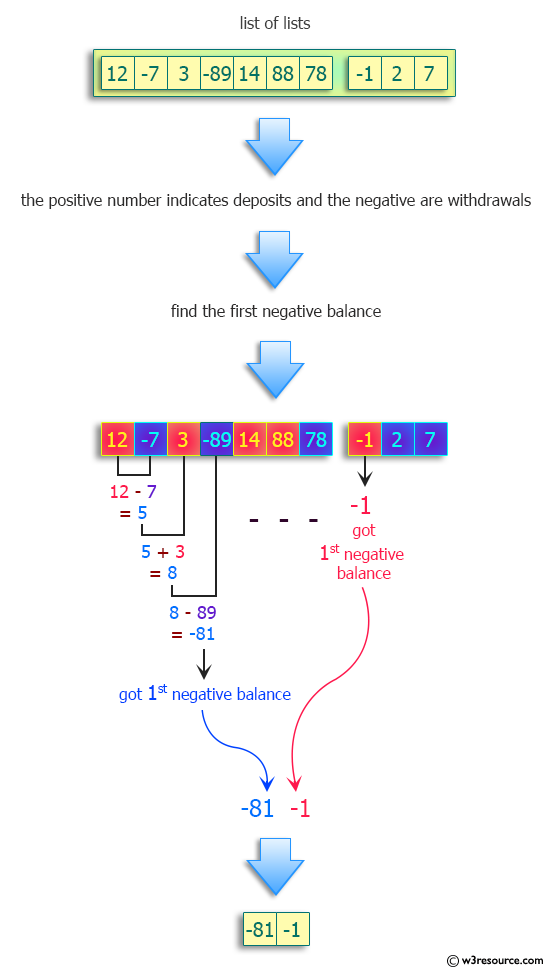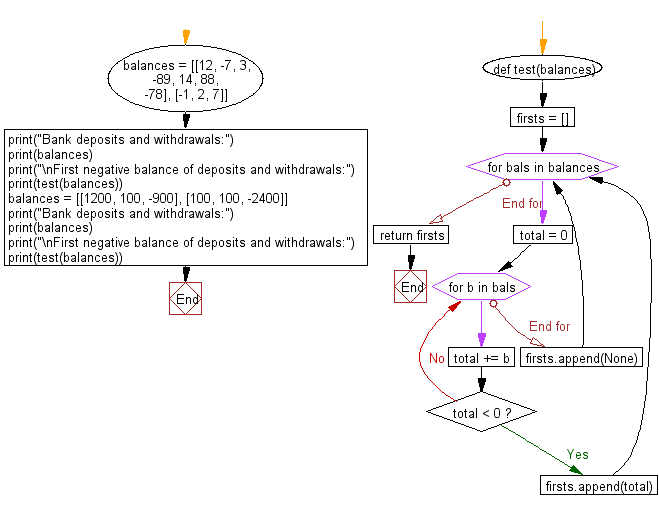Python: Find the first negative balance
Python Programming Puzzles: Exercise-70 with Solution
Write a Python program to find the first negative balance from a given a list of numbers which represent bank deposits and withdrawals.
Input: [[12, -7, 3, -89, 14, 88, -78], [-1, 2, 7]] Output: [-81, -1] Input: [[1200, 100, -900], [100, 100, -2400]] Output: [None, -2200]
Pictorial Presentation:

Sample Solution:
Python Code:
#License: https://bit.ly/3oLErEI
def test(balances):
firsts = []
for bals in balances:
total = 0
for b in bals:
total += b
if total < 0:
firsts.append(total)
break
else:
firsts.append(None)
return firsts
balances = [[12, -7, 3, -89, 14, 88, -78], [-1, 2, 7]]
print("Bank deposits and withdrawals:")
print(balances)
print("\nFirst negative balance of deposits and withdrawals:")
print(test(balances))
balances = [[1200, 100, -900], [100, 100, -2400]]
print("Bank deposits and withdrawals:")
print(balances)
print("\nFirst negative balance of deposits and withdrawals:")
print(test(balances))
Sample Output:
Bank deposits and withdrawals: [[12, -7, 3, -89, 14, 88, -78], [-1, 2, 7]] First negative balance of deposits and withdrawals: [-81, -1] Bank deposits and withdrawals: [[1200, 100, -900], [100, 100, -2400]] First negative balance of deposits and withdrawals: [None, -2200]
Flowchart:

Visualize Python code execution:
The following tool visualize what the computer is doing step-by-step as it executes the said program:
Python Code Editor :
Have another way to solve this solution? Contribute your code (and comments) through Disqus.
Previous: Create a new string by taking s, and word by word rearranging its characters in ASCII order.
Next: Inject a number in between each pair of adjacent numbers in a list of numbers.
What is the difficulty level of this exercise?
Test your Programming skills with w3resource's quiz.
Python: Tips of the Day
Find current directory and file's directory:
To get the full path to the directory a Python file is contained in, write this in that file:
import os dir_path = os.path.dirname(os.path.realpath(__file__))
(Note that the incantation above won't work if you've already used os.chdir() to change your current working directory, since the value of the __file__ constant is relative to the current working directory and is not changed by an os.chdir() call.)
To get the current working directory use
import os cwd = os.getcwd()
Documentation references for the modules, constants and functions used above:
- The os and os.path modules.
- The __file__ constant
- os.path.realpath(path) (returns "the canonical path of the specified filename, eliminating any symbolic links encountered in the path")
- os.path.dirname(path) (returns "the directory name of pathname path")
- os.getcwd() (returns "a string representing the current working directory")
- os.chdir(path) ("change the current working directory to path")
Ref: https://bit.ly/3fy0R6m
- New Content published on w3resource:
- HTML-CSS Practical: Exercises, Practice, Solution
- Java Regular Expression: Exercises, Practice, Solution
- Scala Programming Exercises, Practice, Solution
- Python Itertools exercises
- Python Numpy exercises
- Python GeoPy Package exercises
- Python Pandas exercises
- Python nltk exercises
- Python BeautifulSoup exercises
- Form Template
- Composer - PHP Package Manager
- PHPUnit - PHP Testing
- Laravel - PHP Framework
- Angular - JavaScript Framework
- Vue - JavaScript Framework
- Jest - JavaScript Testing Framework
